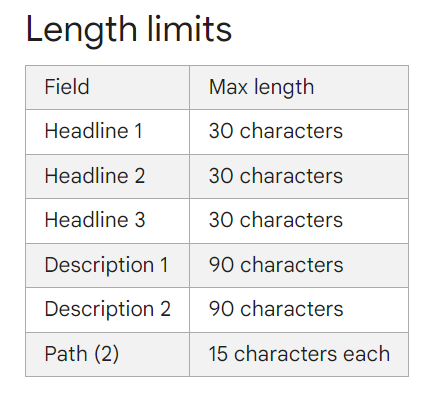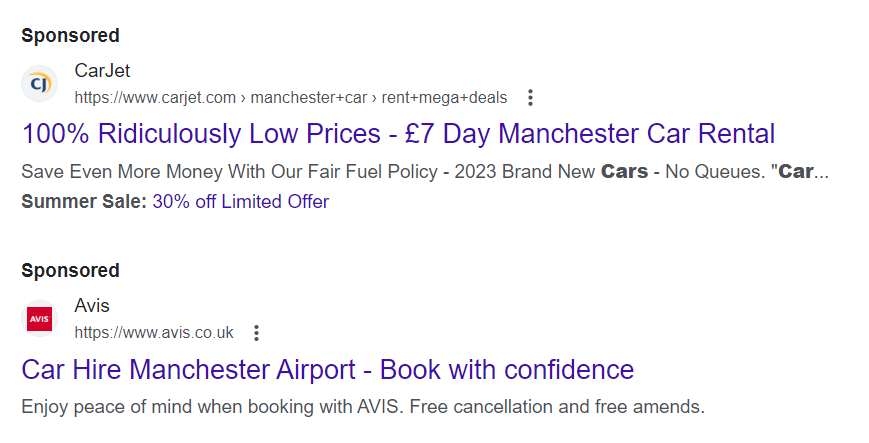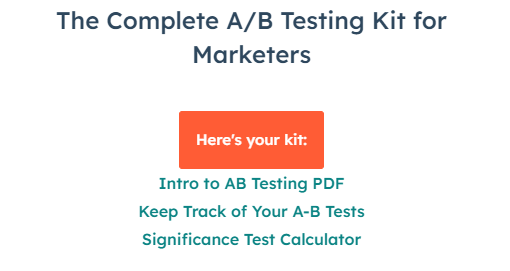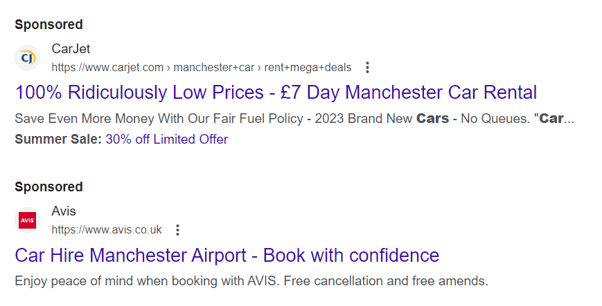PPC ads don’t look like much, but a phenomenal amount of work goes into the ones that perform best. With just a few lines of text, an effective PPC ad needs to capture attention, communicate relevance, and convince a user to convert. Sounds easy, but trust us: it isn’t always.
The best ads are those which are underpinned by knowledge and research, and subject to thorough testing and ongoing refinement. If you want to learn how to write the type of PPC ad copy that will get your ads into this category, read on.
In this article we’ll cover:
- What is PPC Ad Copy?
- Understanding the Fundamentals of PPC Ad Copy
- Importance of First Impressions
- The Role of Display URLs and Ad Extensions
- Basics of A/B Testing for Ad Copy
- Industry-Specific Tips and Best Practices
What is PPC Ad Copy?
Ad copy refers to the text or content of a PPC advertisement. This is the message that your audience will read or engage with.
Just like how a billboard or TV advert has a catchy phrase or message, your PPC ad will have its own unique copy designed to grab attention, convey a message, and prompt the reader to take a desired action, be it clicking through to your website, making a purchase, or filling out a contact form.
Crafting a compelling ad copy is both an art and a science. It needs to be persuasive, relevant to the targeted audience, and aligned with the keywords or search queries that trigger the ad to show up in the first place.
Understanding the Fundamentals of PPC Ad Copy
Expectations are high for ad copy. It has to capture attention, communicate relevance, and convince a prospect to engage, all in a fairly restricted amount of space and time. To put this in context, let’s look at the amount of space you’ve got to work with.
Google frequently change the look and feel of their ads, but the current criteria for ad copy length are as follows:

About Text Ads, August 2023
Google will serve the headline and description it feels is most relevant to the user’s needs, meaning that your ad will be a maximum of 120 characters. Here are the fundamentals of what your ad copy needs to achieve with those characters:
- Draw the eye: Your ad copy needs to invite users to read it, rather than skim over it.
- Communicate relevance: You need to demonstrate why and how your ad is relevant to a user’s search.
- Convey your brand message: You need to articulate the product or service your business has that aligns with your user’s intended outcomes.
- Convince them to engage: The most important step is to persuade them to click and to begin a series of interactions which will hopefully end with a purchase.
This is a tall order, to say the least. Crafting effective ad copy is an art form, and in the following sections, we’ll tell you how to do it.
First, though, let’s look at the anatomy of a PPC ad.
The Anatomy of a PPC Ad
We’ll use the following ad as an example to demonstrate the basic elements. You may see more advanced elements in ads, and we’ll address some of these later.

- Ads are marked as ‘Sponsored’ so that users can easily distinguish between advertorial and organic content. Over the years this has become less obvious, with speculation that Google wants to increase the likelihood of users interacting with ads.
- The display URL shows users the website they’ll be taken to if they click the ad. Some ads have the URLs split out so that users can more easily see the constituent sections; we’ll see this later.
- The headline is part of the ad copy where users get a concise summary of what the ad is about.
- The description is the biggest chunk of ad copy that articulates in more detail what users can expect when they engage with the ad.
Importance of First Impressions
When a user sees ads in the SERPs, they will make a subconscious decision very quickly about which ad to engage with, if they engage with any at all.
To test this, let’s look at two ads that appear in the SERP for ‘car rental Manchester’. Take a look at each, and think about what stands out:

Here are our observations:
- Very different tone: The first ad is lively, enthusiastic, and visually jaunty Thanks To The Overuse Of Capitalisation. The second ad is more measured, and more calmly communicates what you can expect.
- Numbers vs. no numbers: The first ad has lots of numbers - 100%, £7, 2023, 30% - whereas the second ad has none. This subtly shifts the way you engage with each.
- Specific destination: The second ad makes an educated guess about broader search intent by appending ‘Airport’ to the headline.
- The focal USPs: The first ad shouts about a fair fuel policy, new cars, no queues, and a discount; the second spotlights free cancellation and amends. These appeal to different user profiles.
Now think about which ad you’d be more likely to click on, and why? And imagine asking 100 people the same question: Do you think they’d all pick the same ad as you?
The takeaway here is that the way an ad is phrased and structured can lead to very different first impressions, and these impressions will determine whether and how a user engages with an ad. Also, there is no right and wrong: different ads will appeal to different people based on their needs, their personalities, and a million other factors.
The goal therefore is not to create the perfect ad: it’s to understand best practices, to experiment with different variations, and to monitor performance to help you make improvements over time.
Top Insights for Effective Ad Copy
Here are some actionable tips for effective ad copy, distilled from the insights above:
- Use action verbs: ‘Book with confidence’, ‘Save even more money’ - using verbs effectively will encourage a user to take an action, and clear instructions are more likely to lead to a conversion than ambiguous suggestions.
- Consider creating a sense of urgency to harness FOMO: ads that communicate urgency can coax a user towards taking an action, but they can put people off as well. The limited offer mentioned in the first ad above is a good example of using urgency, but note that the second ad doesn’t use this technique at all.
- Demonstrate trust: By showing users that others have used and benefited from your product or service, you strengthen the case for their engagement.
- Be clear: clarity is important, regardless of the tone your ad employs. Users need to quickly understand what the ad is offering and their potential routes to engagement: this lets them make an informed decision about whether or not to engage.
- Demonstrate relevance: Alongside clarity, relevance is the key consideration for ad copy. Users need to understand why your product or service is relevant, and how it aligns with their needs. Effective keyword research is instrumental in understanding search intent and understanding the best phraseology for demonstrating relevance.
- Use the right amount of words: ad copy is subject to enforced brevity by nature, but don’t feel you have to use the full character limit. Sometimes the right message can be conveyed with fewer words.
- Communicate your value proposition: Outline your USPs and give users a reason to engage with you. As the examples above show, there are many ways to frame these, and the configuration you choose will depend on your business, your brand, and other factors.
The Role of Display URLs and Ad Extensions
It’s not just headlines and descriptions that determine what your ad communicates and how effective it is. The display URL can be leveraged to make an impact or emphasise an aspect of your ad, as can ad extensions.
In this section, we’ll take a look at the potential benefits offered by each.
Display URLs
Let’s take another look at one of the previous examples. Note how the URL isn’t in the usual format: instead, there are > characters separating sections, breaking the URL out into three parts:
- carjet.com
- manchester+car
- rent+mega+deals
This is a great example of using the display URL to get more keywords into the ad. Repeating Manchester car in the URL re-emphasises geographical relevance, while ‘rent+mega+deals’ lets the user know they can expect a deal.
Here, again, the decision you make will influence the tone of your ad. The second advertiser’s choice to just go with their home URL contributes to the calm and measured tone of the overall ad.
Ad Extensions
Looking again at the example in the previous section, note the ‘Summer Sale’ callout:

This is not part of the ad anatomy we looked at earlier. Instead, it’s additional information that Google gives advertisers the option to display. As this is an extensive topic we recommend reading about it in more detail on Google’s support pages, but we’ll give a top-level summary here:
- There are multiple types of additional information you can choose to display on your ads
- These are designed to expand the information a user has access to and to help your ad align more closely with their search intent
- You can choose to add information about things like promotions, product prices, site links, related videos, and more
- There is no additional cost to display this information
- Google will determine on a case-by-case basis which additional information - if any - to show, and this decision will be made based on various factors including the user’s search intent, your ad rank, and more (click here to learn more about ad rank)
Basics of A/B Testing for Ad Copy
So far we’ve seen the elements that comprise the basic ad anatomy, and how these can make a significant impression with only a small amount of copy. We’ve also seen how additional elements can be leveraged to expand and strengthen ads.
At this point, you might be feeling a little bit overwhelmed. After all, how do you know what your copy should include, let alone whether or not it’s going to be effective?
The answer is simple: A/B testing.
A/B testing lets you compare different ad variations to see which performs best. And it’s not just whole ads you can compare, either: you can compare granular elements to determine which iterations and combinations deliver the best results.
By testing elements, reviewing test results, and refining ads accordingly, you can make informed refinements to your ads on an ongoing basis. This means that performance will be optimised over time, theoretically resulting in better conversions and higher ROI.
Tools for A/B Testing
Unfortunately, Google is sunsetting its popular A/B testing tool in late 2023, but there are some alternatives.
- Google Marketing Platform: This advertising and analytics platform contains tons of powerful features, many of which incorporate machine learning to make ongoing refinements to ads based on past performance. While this isn’t A/B testing in the usual sense, where the user sets test parameters, monitors results, and makes decisions accordingly, it does reflect Google’s attempt to incorporate educated refinement of ad strategies into its tools.
- HubSpot’s Complete A/B Testing Kit for Marketers: This is a set of resources that offer an incredible depth of insight into designing, monitoring, and implementing insights from A/B tests. As well as an extensive PDF that covers A/B testing in detail, you’ll find a spreadsheet for calculating test significance, which has detailed instructions to facilitate ease of use. (Note: If you’ve read our landing page blog post, you may question why HubSpot make you fill in so many fields to access this resource!)

- Crazy Egg: As well as heatmaps and recordings that give insight into user engagement with your pages, Crazy Egg also offer sophisticated A/B testing tools. Experimenting with different headlines, copy, or other elements is made easy by the interface, and no coding is required to get tests going. This makes A/B testing more accessible and gives any advertiser a chance to iterate their ads.
What to Consider When Setting Up Tests
We strongly recommend utilising A/B testing in your B2B PPC campaign. Taking the following points into account will help you to run effective tests with useful results:
- Set clear objectives: You need to know at the outset what you’re actually testing for, otherwise, you don’t have a frame of reference for your results.
- Set your variables: While we recommend A/B testing multiple elements, we also recommend testing each one in isolation. This makes it easier to attribute differences to a specific change, rather than trying to untangle which of 3-4 changes was responsible.
- Choose the right audience: A/B tests work best when you target an audience whose behaviour you understand fairly well, as you can more easily attribute differences in behaviour to the changes made.
- Set a decent target sample size: A/B testing works best at volume because the more data points you have the less likely it is that the observed result is down to chance.
- Run the test for long enough: your test needs to run for long enough that your target sample size is met, otherwise, the efficacy and utility of the test is reduced.
- Track the right metrics: When you’re making adjustments to copy, metrics around engagement are the ones to keep an eye on. Things like click-through rate (CTR), conversion rate, and so on. See more about the best metrics to track in the following section.
Metrics to Track When A/B Testing
Here are the metrics we would recommend tracking when A/B testing PPC ads:
- Click-through rate (CTR): Higher CTR means higher engagement; look for the ad variation with the highest CTR.
- Conversion rate: the ultimate goal is conversions, so if CTR is higher but the conversion rate remains the same (or drops), try something different.
- Cost per click (CPC): A lower CPC means a lower campaign spend and a variant with a lower CPC suggests that Google determined the ad to be more relevant.
- Quality score: This metric is assigned by Google to show the relative quality of your ad. A higher quality score leads to better placement and lower PPC, so look for variations that improve this metric.
Industry-Specific Tips and Best Practices
The specific requirements of effective ad copy will vary depending on the industry you operate. As we’ve discussed in another blog post, the B2B buying cycle features more stakeholders and is likely to be much longer and more complex than its B2C equivalent. As a result, ad copy needs to function slightly differently.
While each industry will have its own criteria, here are some B2B-specific best practices for effective ad copy:
- Focus on solutions: Your prospective customers likely want a very specific problem-solving, meaning an articulate solution will appeal to more than a vague list of features.
- Emphasise long-term value: greater costs, longer sales cycles and the presence of multiple stakeholders mean that demonstrating ongoing value and ROI is a much more pertinent consideration for B2B customers.
- Use jargon, but only where necessary: complex language is more acceptable in a B2B context because users will have knowledge of it, but even so, this should be avoided unless absolutely necessary for the purpose of clarity.
- Leverage trust signals: B2B decision-makers respond particularly well to testimonials and other trust signals that demonstrate the solution provider is credible, reliable, and trustworthy.
In Conclusion
PPC ad copy is a unique art form, and getting it right will pave the way for much greater success across your campaign. With such a small amount of space and user attention to work with, the copy in PPC ads has to achieve a lot with a little.
Learning what ads are made of and how to best leverage each element will stand your business in good stead to succeed. As well as testing and refining your ad copy on an ongoing basis.
Still looking for more information about PPC Services? We’ve got you covered. Find out more through one of the article below:
- B2B PPC: What is it & Why is it Important?
- PPC Management: How to Optimise Your Ad Campaigns
- PPC Strategy: A Comprehensive Guide
- PPC Keyword Research: A Comprehensive Guide
- PPC Landing Pages: A Comprehensive Guide
- PPC Tracking: A Comprehensive Guide
- PPC Analysis & Reporting: A Comprehensive Guide
- Why PPC Training Makes Sense for Marketing Managers
- How to Structure your PPC Campaign for Success
Or, why not check out our Definitive Guide to PPC Services.






